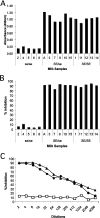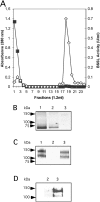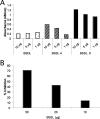Bile-salt-stimulated lipase and mucins from milk of 'secretor' mothers inhibit the binding of Norwalk virus capsids to their carbohydrate ligands
- PMID: 16266293
- PMCID: PMC1360715
- DOI: 10.1042/BJ20050898
Bile-salt-stimulated lipase and mucins from milk of 'secretor' mothers inhibit the binding of Norwalk virus capsids to their carbohydrate ligands
Abstract
Breast-feeding-associated protection against calicivirus diarrhoea is associated with the presence of high levels of 2-linked oligosaccharides in mother's milk, and human calicivirus strains including the NV (Norwalk virus) use gut 2-linked fucosylated glycans as receptors, suggesting the presence of decoy receptors in milk. Our aim was to analyse the ability of human milk to inhibit the attachment of rNV VLPs (recombinant NV-like particles) to their carbohydrate ligands and to characterize potential inhibitors found in milk. Milk from women with the secretor phenotype was strongly inhibitory, unlike milk from women that are non-secretors, which is devoid of 2-linked fucosylated structures. At least two fractions in human milk acted as inhibitors for the NV capsid attachment. The first fraction corresponded to BSSL (bile-salt-stimulated lipase) and the second to associated mucins MUC1 and MUC4. These proteins present tandem repeat O-glycosylated sequences that should act as decoy receptors for the NV, depending on the combined mother/child secretor status.
Figures







Similar articles
-
Glycosylation of bile-salt-stimulated lipase from human milk: comparison of native and recombinant forms.Arch Biochem Biophys. 1997 Aug 1;344(1):94-102. doi: 10.1006/abbi.1997.0188. Arch Biochem Biophys. 1997. PMID: 9244386
-
Histo-blood group antigen and human milk oligosaccharides: genetic polymorphism and risk of infectious diseases.Adv Exp Med Biol. 2004;554:135-43. doi: 10.1007/978-1-4757-4242-8_13. Adv Exp Med Biol. 2004. PMID: 15384573 Review.
-
Norwalk virus binds to histo-blood group antigens present on gastroduodenal epithelial cells of secretor individuals.Gastroenterology. 2002 Jun;122(7):1967-77. doi: 10.1053/gast.2002.33661. Gastroenterology. 2002. PMID: 12055602 Free PMC article.
-
Purified human breast milk MUC1 and MUC4 inhibit human immunodeficiency virus.Neonatology. 2014;105(3):211-7. doi: 10.1159/000357201. Epub 2014 Feb 4. Neonatology. 2014. PMID: 24503884
-
Human milk glycoproteins protect infants against human pathogens.Breastfeed Med. 2013 Aug;8(4):354-62. doi: 10.1089/bfm.2013.0016. Epub 2013 May 22. Breastfeed Med. 2013. PMID: 23697737 Free PMC article. Review.
Cited by
-
Lectin-based analysis of fucosylated glycoproteins of human skim milk during 47 days of lactation.Glycoconj J. 2015 Dec;32(9):665-74. doi: 10.1007/s10719-015-9615-5. Epub 2015 Aug 30. Glycoconj J. 2015. PMID: 26318738 Free PMC article.
-
Elucidating the Implications of Norovirus N- and O-Glycosylation, O-GlcNAcylation, and Phosphorylation.Viruses. 2023 Mar 21;15(3):798. doi: 10.3390/v15030798. Viruses. 2023. PMID: 36992506 Free PMC article. Review.
-
2'-Fucosyllactose inhibits human norovirus replication in human intestinal enteroids.J Virol. 2025 Feb 25;99(2):e0093824. doi: 10.1128/jvi.00938-24. Epub 2025 Jan 10. J Virol. 2025. PMID: 39791912 Free PMC article.
-
Human milk mucin 1 and mucin 4 inhibit Salmonella enterica serovar Typhimurium invasion of human intestinal epithelial cells in vitro.J Nutr. 2012 Aug;142(8):1504-9. doi: 10.3945/jn.111.155614. Epub 2012 Jun 20. J Nutr. 2012. PMID: 22718031 Free PMC article.
-
2'-Fucosyllactose Inhibits Human Norovirus Replication in Human Intestinal Enteroids.bioRxiv [Preprint]. 2024 May 30:2024.05.30.596597. doi: 10.1101/2024.05.30.596597. bioRxiv. 2024. Update in: J Virol. 2025 Feb 25;99(2):e0093824. doi: 10.1128/jvi.00938-24. PMID: 38853945 Free PMC article. Updated. Preprint.
References
-
- Fankhauser R. L., Noel J. S., Monroe S. S., Ando T., Glass R. I. Molecular epidemiology of Norwalk-like viruses in outbreaks of gastroenteritis in the United States. J. Infect. Dis. 1998;178:1571–1578. - PubMed
-
- Bon F., Fascia P., Dauvergne M., Tenenbaum D., Planson H., Petion A. M., Pothier P., Kohli E. Prevalence of group A rotavirus, human calicivirus, astrovirus and adenovirus type 40 and 41 infections among children with acute gastroenteritis in Dijon, France. J. Clin. Microbiol. 1999;37:3055–3058. - PMC - PubMed
-
- Pang X.-L., Honma S., Nakata S., Vesikari T. Human caliciviruses in acute gastroenteritis of young children in the community. J. Infect. Dis. 2000;81:S288–S294. - PubMed
-
- Parashar U. D., Li J. F., Cama R., DeZalia M., Monroe S. S., Taylor D. N., Figueroa D., Gilman R. H., Glass R. I. Human caliciviruses as a cause of severe gastroenteritis in peruvian children. J. Infect. Dis. 2004;190:1088–1092. - PubMed
Publication types
MeSH terms
Substances
LinkOut - more resources
Full Text Sources
Other Literature Sources
Research Materials
Miscellaneous

